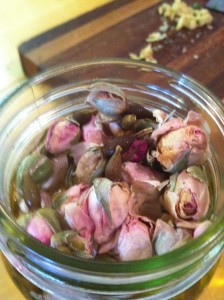This featured herb for maternal care punctures tires, yet makes the urinary channels feel like silk!
Tribulus terrestris is one of the most important herbs in Ayurvedic medicine. This “noxious weed” in the US is called Goat’s Beard or Puncture Vine. Ayurveda calls it Gokshura. It offers the practitioner many uses in maternal healthcare, and though found all over the southwest US, it is seems little known in western herbalism. Perhaps because this hard, multi-sided sharp thorny seed (actually a fruit) easily punctures shoes and bike tires?
I was looking through my notes recently for perinatal and infant health content. So much to digest and use, so many little known abundantly growing herbs! T. terrestris rightfully makes many south-westerners give up their off-road bicycle habit, but when ground it makes the urinary system – and more – very happy.
For pregnancy and postpartum food and medicines, the gokharu (gokshura fruit) was one of the staple herbs in village use. It can be given within the first 10 days after childbirth with guduchi for abnormal postpartum discharge in addition to its applications with the common issues of swellings, burning urine, and rejuvenation. It is an aphrodisiac (rasayana i.e. rejuvenative tonic), helps in conception, preventing miscarriage, certain vaginal disorders, impotency, and shows some effects similar to ashwagandha with animal research. Many other applications below are noted for your interest.
A favorite support best known for kidney function among Ayurvedic students, as herbalists, we often study its gentle effectiveness.
For just this herb, we received many pages of information. Here’s a few tidbits (OK, more than a few):
- Certain types of lactation problems respond very well to a preparation of gokshura with guggulu (gokshuradi guggalu), to remove poor water element management from waste products in the lymph/lactation ducts.
- Gokshura was used in a nutritious sweet for both men and women for rejuvenation. (The sweet component is important to it’s effectiveness for rejuvenative purposes).
- The saponin fraction from Gokshura was demonstrated to exhibit a hypoglycemic effect in alloxan-diabetic rats, with a commensurate reduction in serum triglycerides and cholesterol, and a rise in serum super oxide dismutase (Li et al 2002). Vitiation in triglicerides = tired pancreas.
- The poor people in India used to make a vegetable dish out of Gokshura leaves (though its use is being forgotten).
- The powder from its fruits used to be mixed with other flours to make traditional Indian bread – at least one teaspoon and up to 25% in small batch helps to reduce urinary problems in elders maybe 7-10%. I now add the powder into a flat bread/chapatti, after learning this is standard preventive fare among many village elders. I’m 64 – perhaps one of your village elders.
- An infusion is used to relieve painful micturation, to increase the flow of urine and as a vehicle for diuretic medicines. Used also in incontinence of urine.
- It can reduce allopathic dosages needed in certain cases. You will have to ask those questions of the doctor directly, he gave one example in the lecture and we asked about many other things!
- With black sesame seeds, helps reduce bad energies- circle the person with mix in a bowl, and throw into fire. (Or burn leaves of flax, or keep a bowl of the flax seeds nearby the fragile – helpful for babies, new mamas, the hospitalized, and others. Our unit on Flax brought many new applications for that plant also!)
- With Aam Vata (reheumatoid arthritis) – a decoction with ginger and gokshura is used.
- With ascites and piles. The association of water element managements in the body is related to the reproductive system and emotions around the 2nd chakra, some lactation issues, pancreatic function and a cascade of concerns.
- It may help with cough and asthma, alone or mixed with honey as soothing expectorant.
- It has analgesic effect; may help with pain from neural debility.
- In Paralysis, the preparation called gokshuradi guggulu is particularly good.
- Helps dissolve urinary stones an cystitis. Fresh leaves dipped in water can be drank for medicine, as it creates slipperiness to help release. This remedy is also being forgotten in Ayurvedic practice.
Properties of Gokshura
- Guna (qualities): Guru (heavy), Snigdha (slimy)
- Rasa (taste): Madhur (sweet)
- Virya (energy): Sheeta (cooling)
- Vipak (post digestive effect): Madhur (sweet)
- Very good rasayan
Effects on body channels
- Dosha: Tridoshshamak (cleanses all 3 doshas)
- Dhatus (tissues affected): Shukra, Mamsa, Meda, Rakta (reproductive, muscle, fat, and blood)
- Mala: Mutra (waste system affected: urinary)
- Organs: Urinary system, Cardiac system, Reproductive system, Nervous System
- Dosage: Fruit powder – 2.5 to 5 gm, Decoction – 60 to 100 ml
- Contraindication: Should not be given if patient is suffering from dehydration.
Topics for each herb in the Nighantu class include – an herb’s names and citations throughout the ancient texts; when it began to be used; traditional village dietary and medicinal recipes; which Ayurvedic text says what about it, pharmacokinetics; all useful parts of the plant; effect on metabolism in Ayurvedic and allopathic terms with therapeutic uses and recipes; chemical constituents, uses for each of the shrotamsi (channels) and body systems; herb drug interactions; research on it; growing conditions; varietals; and any contraindications.
As with all information provided, please understand this is partial information. Proper use of herbals per the individual case and condition as well as proper combining, timing, and delivery media are all part of herbal training, and very important. This is not meant to replace the advice of a qualified physician nor prerequisite studies in Ayurvedic medicine.


